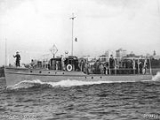
HMAS Kuru
Encyclopedia
HMAS Kuru was an auxiliary patrol boat operated by the Royal Australian Navy
Royal Australian Navy
The Royal Australian Navy is the naval branch of the Australian Defence Force. Following the Federation of Australia in 1901, the ships and resources of the separate colonial navies were integrated into a national force: the Commonwealth Naval Forces...
(RAN) during World War II. Constructed in 1938 for the Northern Territory Patrol Service, Kuru was requesitioned by the RAN following the Japanese declaration of war in December 1941. The ship operated from Darwin, and was one of the vessels used to keep Allied troops in Timor resupplied following the Japanese invasion. Kuru operated until 1943, when she was damaged beyond repair in an accident.
Design and construction
Kuru was built at Balmain, New South WalesBalmain, New South Wales
Balmain is a suburb in the inner-west of Sydney, in the state of New South Wales, Australia. Balmain is located slightly west of the Sydney central business district, in the local government area of the Municipality of Leichhardt....
in 1938 for the Northern Territory Patrol Service and was used to counter poaching by Japanese fishermen. She was 23 metres (75.5 ft) long, had a maximum speed of 9 knots (4.9 m/s), and was armed with a single three-pounder gun.
In RAN service, her armament was increased to an Oerlikon 20 mm cannon
Oerlikon 20 mm cannon
The Oerlikon 20 mm cannon is a series of autocannons, based on an original design by Reinhold Becker of Germany, very early in World War I, and widely produced by Oerlikon Contraves and others...
, a 0.50 calibre M2 Browning machine gun, and several lighter machine guns.
Operational history
Following the outbreak of the Pacific WarPacific War
The Pacific War, also sometimes called the Asia-Pacific War refers broadly to the parts of World War II that took place in the Pacific Ocean, its islands, and in East Asia, then called the Far East...
, Kuru was commissioned into the RAN in December 1941 as an auxiliary
Auxiliaries
An auxiliary force is a group affiliated with, but not part of, a military or police organization. In some cases, auxiliaries are armed forces operating in the same manner as regular soldiers...
patrol boat. HMAS Kuru played an important role in the Battle of Timor from May 1942 and completed numerous supply trips to the island.
In late November 1942, the RAN was called on to evacuate the commandos of the 2/2nd Independent Company
2/2nd Commando Squadron (Australia)
The 2/2nd Commando Squadron was one of 12 independent companies or commando squadrons raised by the Australian Army for service during World War II. The 2/2nd served in Timor, New Guinea and New Britain during World War II, taking part in the Battle of Timor in June 1942 as part of Sparrow Force...
after ten months of guerilla warfare against the Japanese in Timor (an evacuation attempt in September had failed when the destroyer grounded, then was destroyed by Japanese aircraft), a contingent of Dutch troops, and over 100 Portugese civilians, while delivering a relief contingent of Royal Netherlands East Indies Army and Australian soldiers. Kuru and the Bathurst class
Bathurst class corvette
The Bathurst class corvettes were a class of general purpose vessels produced in Australia during World War II. Originally classified as minesweepers, but widely referred to as corvettes, the Bathurst class vessels fulfilled a broad anti-submarine, anti-mine, and convoy escort role.Sixty Bathurst...
corvettes and were assigned to the operation: on 30 November Kuru was to reach Betano Bay
Betano Bay
Betano is a village and suco in southwest of Manufahi District, East Timor. The Suco has 4,577 inhabitants .- History :Betano was a traditional Timorese kingdom in former times....
two hours before the other ships, offload her cargo, and take on the civilians, then meet the corvettes as they arrived and shuttle the fresh troops ashore, with personnel evacuated on return trips. Kuru sailed early on 29 November, and arrived without incident. After offloading the supplies and taking on 70 women and children, the vessel waited for Armidale and Castlemaine to arrive, but after they failed to appear by 02:00 the next morning, sailed for Darwin. The corvettes, which had been delayed by air attacks, found Kuru after dawn, and the civilians were transferred to Castlemaine, with Armidale and Kuru ordered to return by separate routes and attempt the operation again that night. During the day, Kuru was attacked by Japanese aircraft; despite the dropping of over 260 bombs, the vessel suffered only minor damage. At 20:00, the operation was called off as Japanese cruisers had been sighted in the area, and Kuru returned to Darwin on 3 December. Armidale was not so lucky; she was attacked and sunk by Japanese aircraft on 1 December.
Following the evacuation of Timor, Kuru operated in Northern Australia
Northern Australia
The term northern Australia is generally known to include two State and Territories, being Queensland and the Northern Territory . The part of Western Australia north of latitude 26° south—a definition widely used in law and State government policy—is also usually included...
n waters and rescued the survivors of in January 1943.
Kuru was damaged beyond repair by an accident in October 1943.
Kuru was awarded the battle honour
Battle honour
A battle honour is an award of a right by a government or sovereign to a military unit to emblazon the name of a battle or operation on its flags , uniforms or other accessories where ornamentation is possible....
s "Darwin 1942-43" and "Pacific 1942" for her wartime service.

